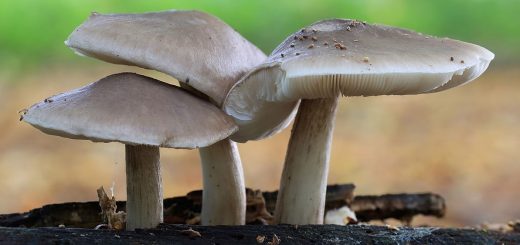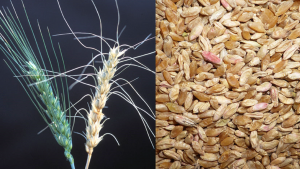#027: Mushroom Morphology: Gilled Mushrooms (“Agarics”) [Archived]
Note: This is an archived post. You can find the current version of this post here.
The gilled mushrooms, informally referred to as “agarics,” are the type of mushroom with which we are most familiar. The most common edible mushrooms (white/button/portabella mushrooms, oyster mushrooms, and shiitake mushrooms) are all gilled mushrooms. Amanita muscaria, the most recognizable mushroom in the world and the inspiration for Mario-style mushroom art, and the “magic mushrooms” are also gilled mushrooms. What all of these mushrooms have in common is a hymenium (spore-bearing surface) that is separate from the sterile, upper part of the fruiting body (the cap/pileus) and that forms “gills.” Gills (known to mycologists as “lamellae”) are plates of spore-producing tissue that form perpendicular to the pileus and radiate out from a single point. The shape of these plates of tissue is reminiscent of fish gills, resulting in the term “gills.” This morphology has apparently been highly successful among mushrooms. If you pick up any field guide to mushrooms, agarics will probably take up over half of the book. The reason that gilled mushrooms are so successful is that gills greatly increase the surface area of the hymenium, which increases spore production.
The above definition of “gills” is necessarily broad because gilled mushrooms have a highly variable morphology. Many agarics, like A. muscaria, have a central stalk called a stipe that supports the pileus. The stipe serves to lift the spore-bearing surface above the layer of stagnant air that surrounds any surface. Gills on agarics with a stipe radiate out from the stipe and may be attached to the stipe in a number of different ways. The stipe itself is variable and may be positioned in the center of the pileus, on the edge of the pileus, or somewhere in the middle. Other mushrooms, like the oyster mushroom, do not form a stem (or, if they do, it is small and lateral). These mushrooms have a “pleurotoid” morphology (named for the oyster mushroom, Pleurotus ostreatus). In pleurotoid mushrooms, the gills radiate from the point at which the mushroom is attached to the wood. These mushrooms do not need a stipe because they are usually found growing on logs and are thus already elevated above the static layer of air. Other variations of the agaric morphology include the color, shape, texture, decorations, and developmental strategy of the gills, pileus, and stipe. All of the differences mentioned above are useful in identifying agaric species.
One reason that there is so much variability within this morphological group of mushrooms is because gills have evolved independently multiple times. Gilled mushrooms are all basidiomycetes (see FFF#013), but the morphological group is polyphyletic. At this point it is important to note that the terms “gilled mushrooms,” “agarics,” and “pleurotoid” do not really have any taxonomic meaning. Instead, they are informal terms that refer to a diverse group of mushrooms that happen to look similar. They are useful, however, in field guides and to help with mushroom identification. Most agarics, including all of the mushrooms mentioned above, belong to the order Agaricales. Gills also evolved in the order Boletales, resulting in the mushrooms commonly known as “gilled boletes.” The gills produced by mushrooms in the order Russulales are indistinguishable from those produced by mushrooms in Agaricales. The order Polyporales also contains a few gilled mushrooms, most notably Lenzites betulina, the “Gilled Polypore” (FFF#168). The order Cantharellales has also produced species with well-developed, gill-like ridges, although these mushrooms are grouped with the “chanterelle” morphology. The order Thelophorales has also produced mushrooms with a chanterelle morphology. This indicates that gills have evolved independently at least four times (or at least six, if you count chanterelles as a subset of agarics). I suspect that the Agaricales were the first to evolve gills, since that order contains the greatest number and the most diverse group of agarics.
See Further:
http://www.mushroomexpert.com/agaricales.html
http://www.mushroomexpert.com/lenzites_betulina.html#essay
http://www.mushroomexpert.com/taxonomy.html
http://tolweb.org/Agaricomycetes/20535 (use the links in the tree at the top of the page to explore relationships between groups of fungi).
Keep up with FFF to learn more about groups of agarics (to be developed).








![#011: Characteristics of Kingdom Fungi [Archived]](https://www.fungusfactfriday.com/wp-content/themes/hueman/assets/front/img/thumb-small-empty.png)


4 Responses
[…] relatively long, and the flesh is fleshy to tough. From above, boletes tend to look a lot like agarics. However, bolete caps are often cracked or eaten away, making it possible for experienced […]
[…] (order Polyporales). Instead, it belongs to the order Agaricales, which contains the majority of gilled mushrooms. 6 The straw-like pore surface is characteristic of the genus Fistulina and closely-related genera. […]
[…] odora belongs to the core group of gilled mushrooms (Agaricales) and is placed in the family Tricholomataceae.5 Tricholomataceae is an unnatural […]
[…] mushrooms should learn to identify this group. In general, amanitas are umbrella-shaped agarics (FFF#027) that usually display all the following features: a universal veil, a partial veil, free gills, and […]